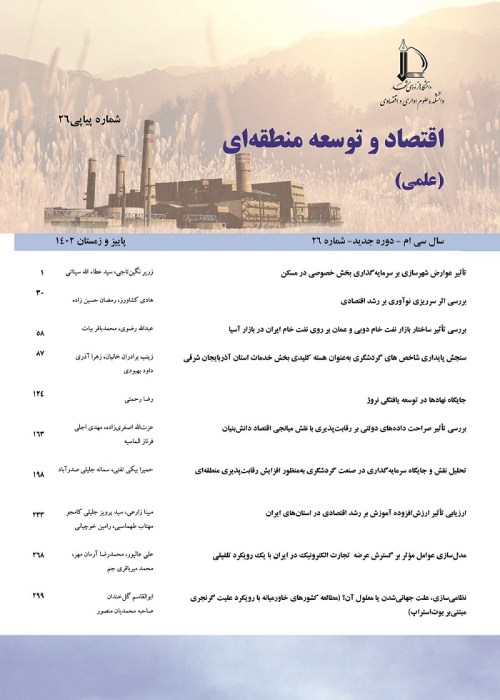Regional Development Influence in Economic and Institutional- Managerial Dimensions from Remittances of Immigrants
Introduction:
Investigating the category of international immigration and sending capital to the hometown and finally, the new role of immigrants under the title of contributors to the development of the new issue is sometimes considered to be investigated and evaluated in many countries. In Iran, with the pre- and post-revolution developments, including the disruption of the rural livelihood system in the wake of the land reform of the 40s, it was a kind of international emigration in parts of the country, most of which migrants were non-skilled workers who sought to unemployment and weaknesses of employment structure within the country. They have been sent to neighboring countries to obtain new employment and income. In this way, a wave of overseas emigration was formed in parts of the country, especially in southern provinces, including parts of Fars, Hormozgan, Boushehr, and Sistan provinces. The main destination of the immigrants is the southern rim of the Persian Gulf, including the United Arab Emirates, Qatar, Kuwait, and Oman. The relatively high volume of capital and cash funds entered into these areas has great consequences and feedback on these regions of the country and has positive and negative dimensions and effects that will be in all social, economic, institutional and community aspects, therefore, the main issue in the study of the impacts and consequences of economic and managerial-institutional results from the entry of capital of international immigrants working in the field of human settlements.
The present study is developmental in the terms of purpose and descriptive and analytical in the terms of method. Documentary and field methods have been used to collect information. In this regard, questionnaires were arranged in four indicators (the indicators of employment status, the amount of the family's empowerment and assets, income and distribution, living expenses, investment amount, managerial awareness and institutional approach) based on the Likert scale and distributed randomly among citizens. The statistical population of the study consisted of 18141 households from 20 villages and towns of the region, which of these households, 314 families have been selected as the sample population based on the Cochran formula. Also, the reliability of the questionnaire was estimated with Cronbach's alpha 648.0. The analysis of the questionnaire was carried out using descriptive and analytical statistical methods including the tests of T, Pearson, multivariate regression and Gray analysis. The variables investigated in this study included immigrants' assets as independent variables and sustainable economic development-management as a dependent variable.
According to the findings, 84.2% of the respondents are men and 15.8% are women, out of which 78.7% are employed, 10.5% are unemployed, 2.2% have other jobs. A comparison of current and former jobs of respondents reveals that nearly 50 percent of those currently earning a living by migrating to the Gulf countries have done so in the past (10 years or more). And 19.3 percent of those formerly immigrants are now engaged in shop and commodity trading in their place of residence, with 54.8 percent of the respondents themselves being immigrants and 44.1 percent of respondents having at least one or more of their family members are among the Gulf refugees. The results obtained from the assessment of respondents perspective using T-test in relation to the effects of immigrant capital of immigrants on economic and managerial-institutional dimensions development shows that Emigrants' remittances have been effective in upgrading and improving the majority of the studied indicators with averages of more than 3 at a significant level less than 0.05 This is indicative of the positive effect of the immigrant ca pitals of immigrants on promoting economic and managerial development indicators in the studied area.
Based on the results of this study, the regional pattern of Larestan Gulf travelers (southern Fars region) shows that in Iran as well as other developing and immigrant countries, international immigrants are a factor of development. These immigrants have identified many of the shortcomings and problems of their hometown and are assigned to solve it, and in various areas, including economic and institutional areas of development, have significant impacts on the areas of immigration and their birthplace. In this regard, the results of the present study indicate that there is a significant relationship between all components and independent variables of the mentioned capitals and the dependent variable of economic and managerial development, and the majority of the aforementioned indicators have a higher mean number than theoretical (3). These results have also been proven in the regression test. The regression results also show that the independent research variable is able to explain 66.0% of the dependent variable changes. The research results indicate that the immigrants' remittance has a strong positive relationship with the economic and institutional-managerial sustainable development by a coefficient of 0.818; and the index of the career and income opportunities has the most effects on the improvement of the economic and institutional- managerial sustainable development indicators by the impact factor of 0.393. According to the results of spatial analysis, villages or cities of Kermunsej, Evaz, Kurdeh, and Zarvan had influenced the most from remittances respectively.
- حق عضویت دریافتی صرف حمایت از نشریات عضو و نگهداری، تکمیل و توسعه مگیران میشود.
- پرداخت حق اشتراک و دانلود مقالات اجازه بازنشر آن در سایر رسانههای چاپی و دیجیتال را به کاربر نمیدهد.



